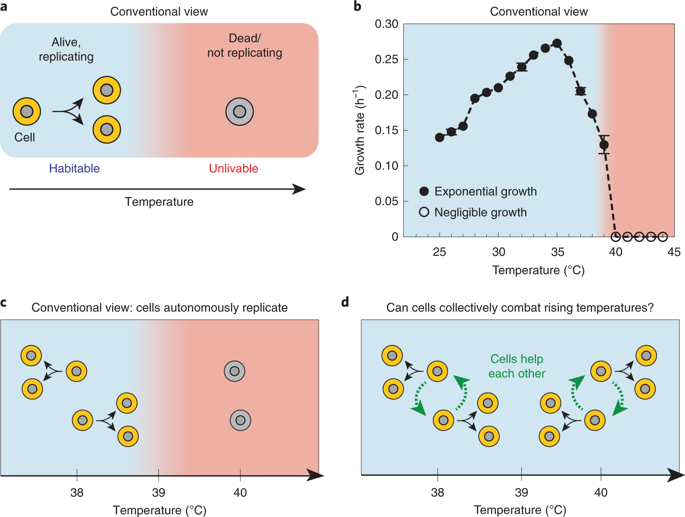当前位置:
X-MOL 学术
›
Nat. Microbiol.
›
论文详情
Our official English website, www.x-mol.net, welcomes your feedback! (Note: you will need to create a separate account there.)
Yeasts collectively extend the limits of habitable temperatures by secreting glutathione.
Nature Microbiology ( IF 28.3 ) Pub Date : 2020-04-20 , DOI: 10.1038/s41564-020-0704-2 Diederik S Laman Trip 1, 2 , Hyun Youk 1, 2, 3
Nature Microbiology ( IF 28.3 ) Pub Date : 2020-04-20 , DOI: 10.1038/s41564-020-0704-2 Diederik S Laman Trip 1, 2 , Hyun Youk 1, 2, 3
Affiliation

|
The conventional view is that high temperatures cause microorganisms to replicate slowly or die. In this view, microorganisms autonomously combat heat-induced damages. However, microorganisms co-exist with each other, which raises the underexplored and timely question of whether microorganisms can cooperatively combat heat-induced damages at high temperatures. Here, we use the budding yeast Saccharomyces cerevisiae to show that cells can help each other and their future generations to survive and replicate at high temperatures. As a consequence, even at the same temperature, a yeast population can exponentially grow, never grow or grow after unpredictable durations (hours to days) of stasis, depending on its population density. Through the same mechanism, yeasts collectively delay and can eventually stop their approach to extinction, with higher population densities stopping faster. These features arise from yeasts secreting and extracellularly accumulating glutathione-a ubiquitous heat-damage-preventing antioxidant. We show that the secretion of glutathione, which eliminates harmful extracellular chemicals, is both necessary and sufficient for yeasts to collectively survive at high temperatures. A mathematical model, which is generally applicable to any cells that cooperatively replicate by secreting molecules, recapitulates all of these features. Our study demonstrates how organisms can cooperatively define and extend the boundaries of life-permitting temperatures.
中文翻译:

酵母通过分泌谷胱甘肽来共同扩大可居住温度的范围。
传统观点认为,高温会导致微生物缓慢复制或死亡。按照这种观点,微生物可以自主抵抗热引起的损害。然而,微生物彼此并存,这提出了在微生物是否可以协同抵抗高温引起的热损害方面尚未充分探索和及时解决的问题。在这里,我们使用出芽的酿酒酵母来证明细胞可以互相帮助,并且它们的后代可以在高温下生存和复制。结果,即使在相同的温度下,酵母种群也可以成倍地增长,永远不会增长,或者在无法预测的持续时间(数小时至数天)停滞后取决于其种群密度而增长。通过相同的机制,酵母菌会共同延迟并最终终止其灭绝的途径,人口密度越高,停顿速度越快。这些特征来自酵母分泌并在细胞外蓄积谷胱甘肽(一种普遍存在的防止热损伤的抗氧化剂)。我们表明,消除有害的细胞外化学物质的谷胱甘肽的分泌对于酵母集体在高温下生存是必要且充分的。数学模型概括了所有这些特征,通常适用于通过分泌分子协同复制的任何细胞。我们的研究表明有机体如何协同定义和扩展允许生命的温度范围。我们表明,消除有害的细胞外化学物质的谷胱甘肽的分泌对于酵母集体在高温下生存是必要且充分的。数学模型概括了所有这些特征,通常适用于通过分泌分子协同复制的任何细胞。我们的研究表明有机体如何协同定义和扩展允许生命的温度范围。我们表明,消除有害的细胞外化学物质的谷胱甘肽的分泌对于酵母集体在高温下生存是必要且充分的。数学模型概括了所有这些特征,通常适用于通过分泌分子协作复制的任何细胞。我们的研究表明有机体如何协同定义和扩展允许生命的温度范围。
更新日期:2020-04-24
中文翻译:

酵母通过分泌谷胱甘肽来共同扩大可居住温度的范围。
传统观点认为,高温会导致微生物缓慢复制或死亡。按照这种观点,微生物可以自主抵抗热引起的损害。然而,微生物彼此并存,这提出了在微生物是否可以协同抵抗高温引起的热损害方面尚未充分探索和及时解决的问题。在这里,我们使用出芽的酿酒酵母来证明细胞可以互相帮助,并且它们的后代可以在高温下生存和复制。结果,即使在相同的温度下,酵母种群也可以成倍地增长,永远不会增长,或者在无法预测的持续时间(数小时至数天)停滞后取决于其种群密度而增长。通过相同的机制,酵母菌会共同延迟并最终终止其灭绝的途径,人口密度越高,停顿速度越快。这些特征来自酵母分泌并在细胞外蓄积谷胱甘肽(一种普遍存在的防止热损伤的抗氧化剂)。我们表明,消除有害的细胞外化学物质的谷胱甘肽的分泌对于酵母集体在高温下生存是必要且充分的。数学模型概括了所有这些特征,通常适用于通过分泌分子协同复制的任何细胞。我们的研究表明有机体如何协同定义和扩展允许生命的温度范围。我们表明,消除有害的细胞外化学物质的谷胱甘肽的分泌对于酵母集体在高温下生存是必要且充分的。数学模型概括了所有这些特征,通常适用于通过分泌分子协同复制的任何细胞。我们的研究表明有机体如何协同定义和扩展允许生命的温度范围。我们表明,消除有害的细胞外化学物质的谷胱甘肽的分泌对于酵母集体在高温下生存是必要且充分的。数学模型概括了所有这些特征,通常适用于通过分泌分子协作复制的任何细胞。我们的研究表明有机体如何协同定义和扩展允许生命的温度范围。



























 京公网安备 11010802027423号
京公网安备 11010802027423号